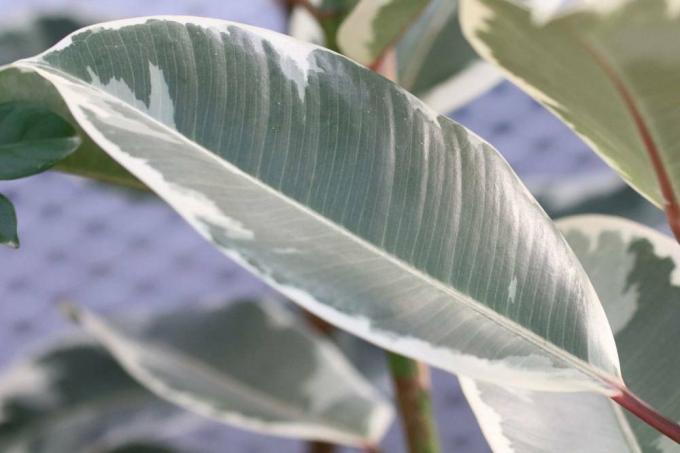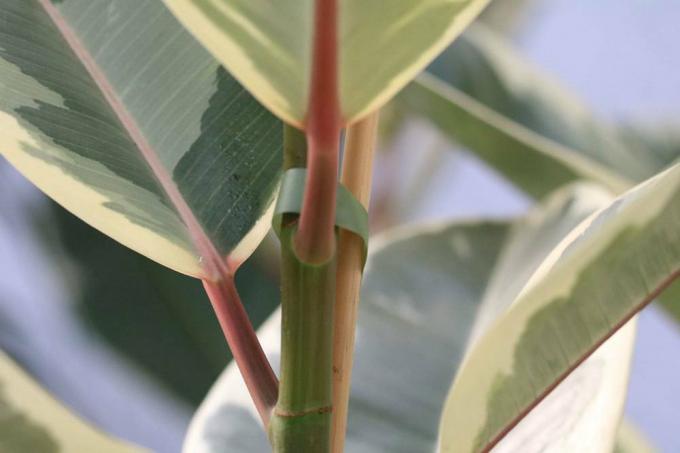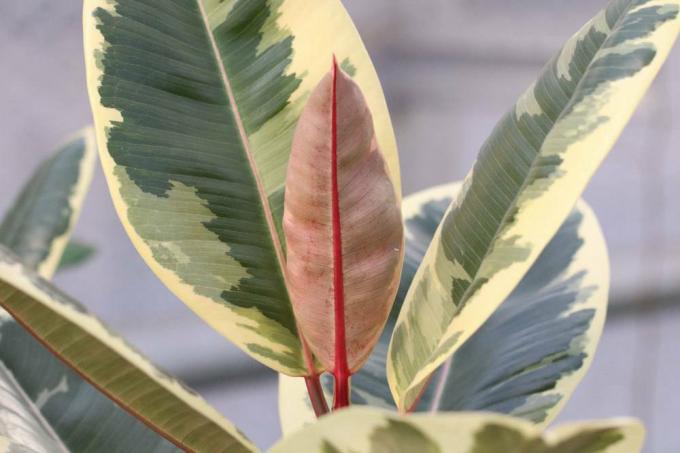
table of contents
- Toxicity
- Symptoms of poisoning
- Toddlers
- Pets
- prevention
- First aid
It is robust, easy to care for and is one of the classics Houseplants: The rubber tree, which is also known under the botanical name Ficus elastica, is valued by plant lovers all over the world. However, its leaves contain a slightly toxic juice that can be harmful to health. For this reason, rubber trees should be kept out of the reach of small children and pets.
Toxicity
How poisonous is the rubber tree?
The leaves of the rubber tree contain a slightly poisonous sap, which is composed of the following components.
- rubber
- wax
- Coumarin
- Chlorogenic acid
Chlorogenic acid
Chlorogenic acid found in many Green plants can cause severe abdominal pain and nausea in babies or young children if accidentally swallowed. Touching the intact rubber tree leaves, on the other hand, is completely harmless and does not cause skin irritation. Tannic acid could be detected in the bark of the rubber tree, which also leads to stomach problems in sensitive people. Therefore, make sure that your offspring do not put the leaves or parts of the bark in their mouths.

Symptoms of poisoning
Toddlers
Typical symptoms of poisoning in babies and children
The thick, plump and deep green leaves of the rubber tree exert a considerable fascination on children. When the little ones tear off the foliage or bite off a piece of it, they inevitably come into contact with the milky sap. This is slightly toxic and, in small doses, can cause unpleasant itching, reddening of the skin and irritation of the mucous membranes. If larger amounts are swallowed, the following symptoms of intoxication often occur.
- Gastrointestinal upset
- Vomit
- stomach pain
- diarrhea
In rare cases, the ingestion of the poison can even cause cramps or paralysis. The taste of the leaves is described as unpleasantly bitter. Because of this, it is very unlikely that your children will consume unsafe amounts of the plant sap.
Pets
The rubber tree endangers dogs, cats and rodents
Pets react more strongly to the poison of the rubber tree than humans. Not only dogs and cats nibble on green houseplants, but also rodents such as rabbits, guinea pigs and hamsters. Ingestion of the toxic juice can cause irritation of the mucous membranes as well as acute nausea. Vomiting and diarrhea are further unpleasant consequences for your pet. Have you observed that your four-legged roommate has swallowed a small piece of the leaf or the bark of a tree? Then you should contact the vet as a precaution. You don't need to panic, however. The taste of the rubber tree is so repulsive that attempts to nibble are usually stopped before serious health problems arise.

prevention
Preventive measures against poisoning
Rubber trees are beautiful and undemanding houseplants that enrich every home. Parents and pet owners don't have to do without this green ornament either. However, you should make sure that the rubber tree is set up in an inaccessible place.
Tip: Smaller copies find enough space on cupboards, chests of drawers or raised window sills.
The easy-care rubber trees feel completely at home even in winter gardens and bright basement rooms. Fallen leaves should be picked up immediately so that children and animals do not come into contact with the parts of the plant. If you don't want to take any risks or can't find a suitable location for the mulberry plant, opt for non-toxic alternatives.
These include, among others:
- Elephant foot
- Coconut palm
- eucalyptus
- Date palm
First aid
First aid for children and pets
The rubber tree is slightly poisonous and can cause both unpleasant skin irritation and stomach discomfort if humans or animals come into contact with its sap. Redness and skin irritation on the hands must be washed off with clear water so that the affected areas can regenerate quickly. If small parts of the plant have been swallowed, the ingested toxins should be diluted with liquid. To do this, give tea or water. If acute symptoms of intoxication such as diarrhea, vomiting or stomach pain occur, a doctor or veterinarian must be consulted immediately.

Conclusion:
- the sap of the rubber tree is slightly poisonous
The evergreen rubber tree is not only decorative, but also slightly toxic. Still, parents and pet owners don't have to go without this popular houseplant if they follow a few precautionary measures. It is safe to touch the leaves as it does not cause any reddening of the skin or health problems. Only the sap of the rubber tree, which is primarily located inside the thick leaves, is poisonous. If the milky juice is accidentally swallowed, it can cause irritation of the mucous membranes, stomach and intestinal problems or other acute symptoms of intoxication. Therefore, the rubber tree should always be placed out of the reach of small children and pets.
Sources:
http://www.gizbonn.de/137.0.html
https://www.botanikus.de/Botanik3/Ordnung/Ficus/ficus.html

